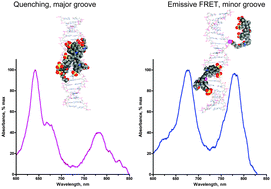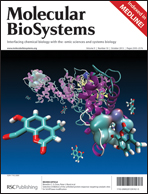The three-dimensional context of a double helix determines the fluorescence of the internucleoside-tethered pair of fluorophores†
Abstract
We report a general phenomenon of the formation of either a fluorescent or an entirely quenched oligodeoxynucleotide (ODN) duplex system by hybridizing pairs of complementary ODNs with identical chemical composition. The ODNs carried internucleoside tether-linked cyanines, where the cyanines were chosen to form a Förster's resonance energy transfer (FRET) donor–acceptor pair. The fluorescent and quenched ODN duplex systems differed only in that the cyanines linked to the respective ODNs were linked either closer to the 5′- or 3′-ends of the molecule. In either case, however, the


 Please wait while we load your content...
Please wait while we load your content...